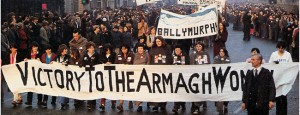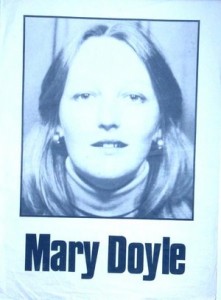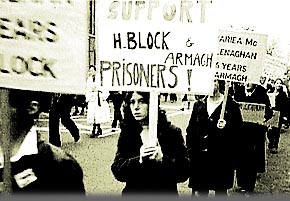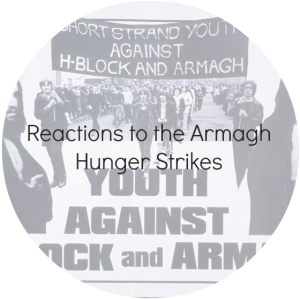In March 1976, the British government moved to declassify the Republican political prisoners. Republican inmates would thus be required to wear a prison uniform and carry out labor. They were also denied rights of association, internal organization and use of time. In March 1977, male Republican prisoners at Long Kesh refused to wear the inmate uniform and instead covered themselves with blankets. A year later inmates were prohibited use of blankets outside their cells; so they came out naked. This reaction to what they felt was harassment and humiliation escalated into the 1978 Dirty Protest.
During this time, the women prisoners at Armagh were participating in the same protests fighting against the withdrawal of political status. In 1977 the republican women prisoners refused to do mandatory prison work, and in response to the no-work protest, the women were kept in their cells all day during work hours. They did not see their protest as different from men and sought the same political recognition. Since female prisoners in Britain were not required to wear a prison uniform, attention was focused strictly on the males. The men had rejected the prison uniform to assert their political identity; so the woman improvised IRA uniforms in a similar metonymical movement. These uniforms often consisted of black polo neck shirts, black skirts and tights.
What led the females to fully delve into the protest was an assault by male prison officials, followed by two days of cell confinement while attempts were made to locate the “subversive garments”. The assault that provoked the Dirty Protest was seen as a political act of discipline involving punishment and “as a humiliating assertion of male dominance”. So the female prisoners decided to engage in the dirty protest and spread their feces and their menstrual blood on the walls of their cells. Many Republican men avoided mentioning menstruation but attempted to dissuade the women from this form of protest with the limited arguments that it was not appropriate for women to do this because they were women. But the women did not care, because they viewed their protests as one in the same. They did not believe they were doing anything vastly different from their male counterparts and wanted the same recognition that they received. But unfortunately, the women’s efforts went virtually unnoticed, and they were essentially invisible compared to the men in Long Kesh. During this time of protest strip searches were a key weapon used by the prison authorities in an attempt to intimidate and humiliate the republican women. While the dirty protest was going on there was a question of beginning a hunger strike, but it was firmly opposed by the leadership on the outside. But for the women in Armagh they felt their situation was intolerable and they felt they needed to try to force a change in their conditions. The leadership in the men’s prison opposed to the women participating in the hunger strikes, but the women were determined to participate as they felt they had an equal stake in achieving the demands.
 While seven men began a hunger strike on October 27th, 3 women from Armagh began the hunger strike on December 1, 1980. The three women who participated in the hunger strike were Mairead Farrell, Mairead Nugent, and Mary Doyle. The three girls were moved into a double cell together, and instead of the usual inedible cold prison food they were receiving before; they were fed with plates overflowing with piping hot food. After a couple of weeks on the hunger strike, the women heard rumors that the hunger strike was over, and that the men had ended the hunger strike. On December 19th they ended the hunger strike, and a sense of relief and happiness and satisfaction washed over the women believing that their demands would be met. But shortly after Christmas it became clear that the British had reneged on the agreement and had no intention of addressing the five demands. In January the women began discussing a second hunger strike, but with only 30 prisoners in their wing at the jail, they made the assessment that they would not be able to sustain a second hunger strike. But the women kept up with the no-work protest and supported their male comrades from their cells in Armagh. It is women who have been the backbone of the republican struggle. The women of Armagh were brave and sacrificed for their Irish freedom. For them, even though they received little attention, they still fought and struggled to ensure that their message was being heard.
While seven men began a hunger strike on October 27th, 3 women from Armagh began the hunger strike on December 1, 1980. The three women who participated in the hunger strike were Mairead Farrell, Mairead Nugent, and Mary Doyle. The three girls were moved into a double cell together, and instead of the usual inedible cold prison food they were receiving before; they were fed with plates overflowing with piping hot food. After a couple of weeks on the hunger strike, the women heard rumors that the hunger strike was over, and that the men had ended the hunger strike. On December 19th they ended the hunger strike, and a sense of relief and happiness and satisfaction washed over the women believing that their demands would be met. But shortly after Christmas it became clear that the British had reneged on the agreement and had no intention of addressing the five demands. In January the women began discussing a second hunger strike, but with only 30 prisoners in their wing at the jail, they made the assessment that they would not be able to sustain a second hunger strike. But the women kept up with the no-work protest and supported their male comrades from their cells in Armagh. It is women who have been the backbone of the republican struggle. The women of Armagh were brave and sacrificed for their Irish freedom. For them, even though they received little attention, they still fought and struggled to ensure that their message was being heard.




